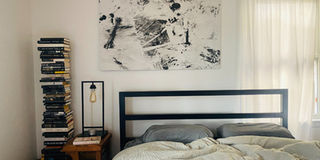Prime
Six steps to make your room feel like home on a budget

The colour and design of a bedspreads can impact a room. PHOTO/UNSPLASh.com
What you need to know:
- Lighting is one of the very important ways to change the ambience of a room. You can add warmth to a room with soft furnishings and personal photos.
With the prospect of home ownership a distant dream, many young people opt to rent a room in a shared flat or student accommodation. While tenancies can be short, research shows that a poor home environment can very quickly become a source of stress, and that is the last thing you need, when studying or starting out in a new job.
Paint
First things first; come up with a “colour story” and try to stick with it. A good way to do this is to pick three colours. The first colour will act as the main colour, taking up about 60 percent of the space, while the second will act as a complementary colour, taking up 30 percent, and the third will be an accent, using only about 10 percent of the space.
Once you have decided on your colour story, you need to start thinking about all the other objects in the room and how they interact with one another. Apply your colour proportions to them, thinking about how much space the different elements take up.
Walls take up a large proportion of your room and act as the backdrop to everything else, so their colour makes a big difference. Get in touch with your landlord to find out if you are allowed to paint your walls and offer to restore the original colour when you leave.
Colours can help to convey a mood, so think carefully about the paint you will use; do you want your room to feel lively? Then pick a bright colour such as yellow, pink or blue. Do you want your room to have a more relaxed feel? Then opt for more muted tones.
If you intend on buying new paint, buy from the manufacturer as this is a lot cheaper than buying retail. But before you do, get hold of paint charts, these are free and will help you to see how work colours together in order to make a choice.
Refresh the bedspread
Bedspreads cover quite a large surface area, so the design and colour can really impact a room. If you are not painting your walls, this is where you should inject your primary colour. And if your budget does not stretch to buying new bed linen, here are ideas to spruce yours up or make your own:
Dip dye your existing set with a complementary colour, using supermarket fabric dyes.
Tie dye your existing set, using one of the many Shibori techniques, with supermarket fabric dyes.
Use fabric pens to draw your own design.
Pick up some old sheets you like from a market or charity shop and sew them together to make a duvet cover.
Add soft furnishings
Add some scatter cushions to your bed in your complementary and accent colours. Buy plain cushions from a second hand shop or market and add your own embellishments and designs. You can use dye techniques, fabric paint, pens, pompoms or tassels.
Hang pictures
If you have got prints for the wall, second hand shops often sell inexpensive frames, and you can paint them different colours using sample paint pots from a hardware store.
Instead of scrolling through pictures of family and friends on social media, which can sometimes make you lonelier, you can peg printed images to a string of fairy lights or bunting.
Books
Colour code your books for a gorgeous rainbow effect. And plants bring a bit of life indoors, while the green foliage looks very sophisticated. Plants also absorb carbon dioxide and release oxygen, and have some capacity to reduce indoor air pollution. They can reduce physiological and psychological stress and flowers in particular can improve your mood.
Authored by Sian Elin Thomas





